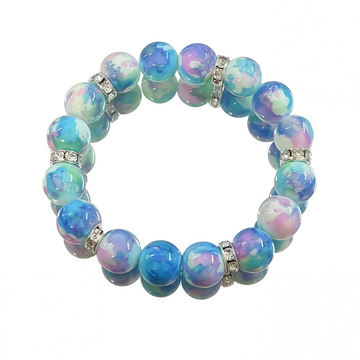The material options for stone bracelets are rich and diverse. Different materials have unique appearances, textures and characteristics. Here is a detailed introduction for you:
Natural gemstones
Jadeite: This is a kind of hard jade with a rich variety of colors. Common ones include green, purple, white, etc. Jadeite has a warm and fine texture, with a vitreous or oily luster. It is relatively hard but has relatively poor toughness. During wearing, it is necessary to avoid collisions. High-quality jade bracelets are bright in color and transparent in texture, possessing high ornamental and collection value.
Hetian jade: It belongs to nephrite and is renowned for its warmth, fineness and oily luster. Hetian jade comes in various colors such as white jade, green jade, jasper, yellow jade and black jade. It has a compact structure, good toughness, is not easy to break, and feels comfortable when worn, giving people a soft and warm feeling. It has always been highly praised in traditional Chinese culture.
Agate: It is a kind of chalcedony with a banded structure. It has bright colors, and common ones include red, yellow, blue, green, etc. Agate has a relatively high hardness and a relatively brittle texture. Its surface often presents unique textures and patterns, such as banded agate and onyx, which have a distinctive decorative effect.
Crystal: Its main component is silicon dioxide. It has high transparency and a variety of colors, such as amethyst, citrine, rose quartz, white quartz, etc. Crystal has a glassy luster and a relatively high hardness. Some crystals also possess special optical effects, such as the starlight effect and the cat's eye effect, which can enhance the unique charm of bracelets.
Garnet: It comes in a variety of colors, with common ones including red, orange, green, etc. Garnet has a relatively high hardness, strong luster and good transparency. Some garnets also have a starlight effect. It is believed to have the effects of promoting blood circulation and enhancing vitality, and is also quite popular in the jewelry market.
Semi-gemstone category
Tourmaline: It is a borosilicate crystal with extremely rich colors and is hailed as "the rainbow that has fallen to the earth". Tourmaline is relatively hard but rather brittle. Different colors of tourmaline carry different meanings and effects. For instance, red tourmaline symbolizes passion, while pink tourmaline represents love.
Topaz: Also known as yellow jade, it comes in colors such as blue, yellow, pink, and colorless. Topaz has high transparency, strong luster and high hardness. After processing, it can present a brilliant luster and is a gemstone material with relatively high cost performance.
Moonstone: It has a unique moonlight effect. Under the illumination of light, it presents a hazy blue or white mottled effect, as soft as moonlight. Moonstone has a moderate hardness and fine texture, and is often used to make romantic and elegant jewelry.
Organic gemstones
Coral: It is formed by the accumulation of calcareous skeletons secreted by coral polyps. It has bright colors, and common ones include red, pink, white, etc. Coral has a warm texture and soft luster, but it is relatively hard and fragile, requiring meticulous care. Due to the slow growth rate of coral and its relatively scarce resources, it has certain collection value.
Pearls: They are divided into freshwater pearls and saltwater pearls, and their colors include white, pink, purple, black, etc. Pearls have a soft luster and a warm texture. Wearing them can showcase an elegant and noble demeanor. However, pearls have relatively low hardness and are afraid of acids, alkalis and friction. It is necessary to avoid contact with sharp objects and chemical substances.
Ores
Malachite: It is named for its color resembling the green spots on a peacock's feathers, and it has unique textures and colors. Malachite has a relatively low hardness and a rather brittle texture. It is usually processed into various uniquely shaped bracelets, showcasing a natural beauty.
Lapis lazuli: Its color is mostly deep blue or purplish blue, often accompanied by golden or white spots, just like the stars in the night sky. Lapis lazuli has a moderate hardness and a certain luster. In ancient times, it was regarded as a precious gemstone material and was often used to make jewelry and handicrafts.







